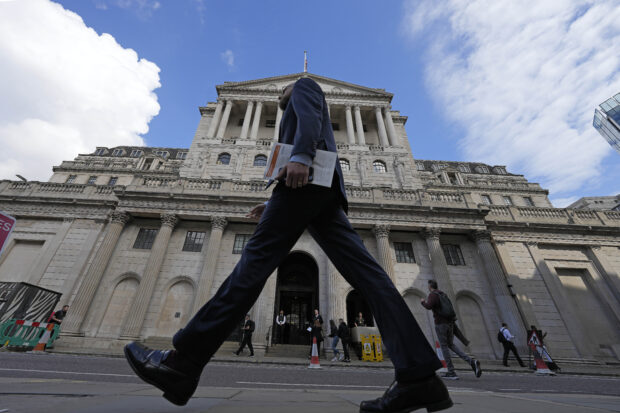UK borrowers brace for more expensive loans as inflation fails to fall as anticipated

A man walks past the Bank of England, at the financial district in London, on May 11, 2023. Consumer price inflation across the U.K. was unchanged at 8.7% in the year to May against expectations for a modest decline, official figures showed Wednesday, June 21, 2023, a development that is set to see the Bank of England raise the cost of borrowing again. (AP Photo/Frank Augstein, File)
LONDON — Borrowers in the U.K. will be bracing themselves for further increases in lending costs after official figures Wednesday showed inflation failing to fall as anticipated in May.
The Office for National Statistics said inflation, as measured by the consumer prices index, held steady at 8.7 percent in the year to May against expectations for a modest decline to 8.4 percent, a development that is likely to see the Bank of England raise the cost of borrowing again on Thursday.
The agency said rising prices for flights, recreational and cultural goods and services, and second-hand cars boosted the inflation rate, while gas prices at the pump provided the biggest downward pressure.
“After last month’s fall, annual inflation was little changed in May and remains at a historically high level,” the agency’s chief economist Grant Fitzner said.
Financial markets think news of the unchanged rate will mean the Bank of England will increase its benchmark interest rate on Thursday from the current 15-year high of 4.5 percent by a quarter-point to 4.7 percent.
Article continues after this advertisementBank of England poised to raise rates again to tackle stubborn inflation
Some economists think the bank, which is tasked with keeping inflation at around 2 percent, may decide to go further and raise it to 5 percent. Higher interest rates help lower inflation by making it more expensive for households and businesses to borrow, meaning they potentially spend less, thereby reducing upside demand pressure on prices.
Article continues after this advertisement“This makes a rate rise by the Bank of England this week near certain and materially increases the likelihood of further rises well into autumn,” said Debapratim De, senior economist at Deloitte.
The anticipated increase will pile further pressure on financial institutions to increase their own lending rates for loans and mortgages.
Many homeowners will be cushioned from the recent increases as they fixed their mortgages when interest rates were ultra-low during the coronavirus pandemic. However, those whose fixed rate terms expire over the coming months will face much higher borrowing rates when they look to lock in new deals.
“It’s a ticking time bomb as 1.4 million borrowers will see an end to their low fixed rates this year,” said Jamie Elvin, director at mortgage broker Strive Mortgages.
Unlike the United States, where many homeowners fix their mortgage rates for 30 years, the prevailing habit in the U.K. is for homeowners to fix a rate for much shorter periods of time, after which they move to their lender’s usually higher variable rate or seek out other deals. In the current climate, for example, those who fixed their mortgage rate at below 1 percent three years ago may see a fivefold increase in their rates.
Like other central banks, the bank has aggressively raised borrowing rates over the past 18 months or so after inflation spiked sharply, first because of bottlenecks caused by the coronavirus pandemic and then Russia’s invasion of Ukraine, which sent energy and food prices surging.
RELATED STORIES:
High inflation helps to swell UK budget deficit in April
UK inflation falls by less than expected, core inflation jumps
UK set to have highest inflation among big economies in 2023-OECD